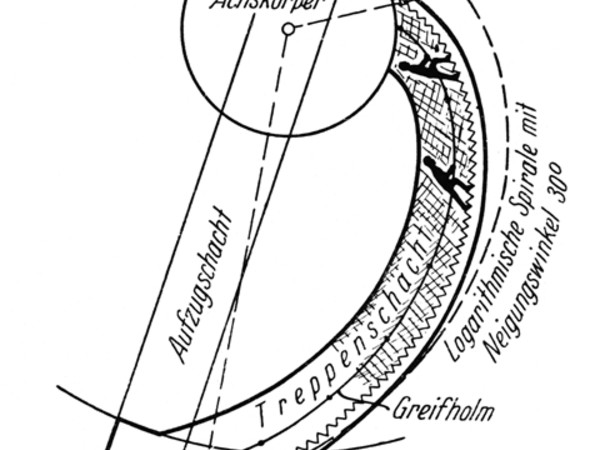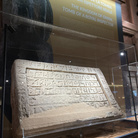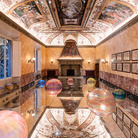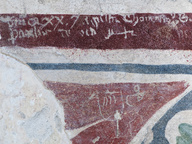The problem of the navigation in the space

Il problema della navigazione nello spazio, Padiglione Sloveno - La Biennale di Venezia
From 07 Giugno 2014 to 23 Novembre 2014
Venice
Place: Pavilion of Slovenia - La Biennale di Venezia
Address: Giardini
Responsibles: Jurij Krpan
Telefono per informazioni: +39 347 7122456
E-Mail info: info@aplusa.it
Official site: http://www.aplusa.it
At the 14th International Architecture Exhibition, the Pavilion of Slovenia, curated by the Cultural Centre of European Space Technologies (KSEVT), delves on the fundamentals of architecture by looking at the work of Slovene engineer Herman Poto?nik Noordung, the pioneer of space architecture. With his 1928 book The Problem of Space Travel – The Rocket Motor, Poto?nik established a first vision of architecture that would enable human survival in dangerous, even deadly conditions of zero gravity.
In the Arsenale, in at the passage between Corderie and Artiglierie, the Pavilion of Slovenia presents Poto?nik’s idea of architecture for space at many levels. For the last few decades, our nearby space has been inhabited with objects of various origin, from satellites to space stations. These human “settlements” perform all kinds of functions in an environment unfriendly to humans, yet they join hands as cultural and architectural artifacts. Poto?nik stands as someone who, first and foremost, used his knowledge to answer the question of how to use technology not in terms of destruction, but for common human purposes and to render the habitation of space possible. The history of space appropriation has always been, consequently, a history of architecture, bound especially to scientific and technological achievements.
In the Pavilion, KSEVT makes a between Science-Technology solutions and the Arts-Humanities appropriation of space, seeing the development of architecture as an intersection of two parallel human efforts. The Arts-Humanities vector, outlined by Poto?nik and his non-militaristic approach to designing space architecture, is to recognize a cultural space in weightlessness and in unnatural conditions to humans.
Poto?nik’s commitment and his architectural contribution can be better understood when framed alongside the history of architectural Modernism, in Slovenia and abroad. We may understand the methodology of Poto?nik’s plans for space architecture – to create an environment for human habitation in a completely inhuman environment, space – through a series of architectural solutions made by prominent Slovenian architects in the past hundred years, despite the fact they were often subjected to a residential and social function, defending the idea of a better life – with all the benefits of a civilization – even for the weakest social groups.
It is not by accident that even some modernists and avant-gardists started to discover space, albeit with their own devices, in the early decades of the 20th century. The search for a new artistic expression often coincided with the invention of a new social order and a new man. Space made a radically new view of art and society entirely possible, so the story of the technological and architectural conquest of space is intertwined with utopian artistic exploration and therefore with the artistic interpretation of what space is and what it implies.
Through three concepts, the Pavilion offers different ways to understand Poto?nik’s space architecture and architectural space in general. Supre:human deals with Noordung’s Technology-Humanities designs for a human living space. Supre:living above all exposes the fact that space is impregnated with cultural artifacts — including architecture — as well as artistic appropriation and even an expansion of this very term. Finally, Supre:composite represents Slovenian architecture in the last century as the predecessor and descendant of Poto?nik’s architectural aspirations; a predecessor that demonstrates the context and mentality of the idea for architecture in a certain area; a descendant who points out the basis of a general reflection – how does the architecture enable human habitation? –, and, because it is born in conditions of new technological solutions, largely connected to the development of space technologies.
Through these three aspects, KSEVT advances a unique look at the past scientific and artistic exploration of space, a look to begin and understand this exploration as a diverse mental effort of space culturalization. KSEVT holds this exhibition in cooperation with the La Biennale di Venezia and is preparing the main presentation in cooperation with the Yuri A. Gagarin Cosmonaut Training Centre from Star City. They will establish a connection of Herman Poto?nik Noordung with the International Space Station, the only inhabited space architecture in Earth’s orbit.
Herman Poto?nik (pseudonym Hermann Noordung; 1892 –1929) was an Austro-Hungarian rocket engineer and pioneer of cosmonautics (astronautics) of Slovene ethnicity. He is chiefly remembered for his work addressing the long-term human habitation of space.
At the end of 1928, he published his sole book, Das Problem der Befahrung des Weltraums – der Raketen-Motor (The Problem of Space Travel – The Rocket Motor) in Berlin. In 188 pages and 100 handmade illustrations, Poto?nik set out a plan for a breakthrough into space and the establishment of a permanent human presence there. He conceived a detailed design for a space station, regarded by Russian and American historians of spaceflight to be the first architecture in space and was the first man to recognize the significance of the geostationary orbit, on which the station would orbit the Earth. He also made first detailed calculations of this orbit. He described the use of orbiting spacecraft for detailed observation of the ground for peaceful and military purposes, and described how the special conditions of space could be useful for scientific experiments. Poto?nik expressed strong doubts of the potentially destructive military use of these fresh discoveries.
Authors: Miha Turši?, Dragan Živadinov
Co-authors: Dunja Zupan?i?, Špela Petri?, Peter Kre?i?, Tanya N. Zhelnina
In the Arsenale, in at the passage between Corderie and Artiglierie, the Pavilion of Slovenia presents Poto?nik’s idea of architecture for space at many levels. For the last few decades, our nearby space has been inhabited with objects of various origin, from satellites to space stations. These human “settlements” perform all kinds of functions in an environment unfriendly to humans, yet they join hands as cultural and architectural artifacts. Poto?nik stands as someone who, first and foremost, used his knowledge to answer the question of how to use technology not in terms of destruction, but for common human purposes and to render the habitation of space possible. The history of space appropriation has always been, consequently, a history of architecture, bound especially to scientific and technological achievements.
In the Pavilion, KSEVT makes a between Science-Technology solutions and the Arts-Humanities appropriation of space, seeing the development of architecture as an intersection of two parallel human efforts. The Arts-Humanities vector, outlined by Poto?nik and his non-militaristic approach to designing space architecture, is to recognize a cultural space in weightlessness and in unnatural conditions to humans.
Poto?nik’s commitment and his architectural contribution can be better understood when framed alongside the history of architectural Modernism, in Slovenia and abroad. We may understand the methodology of Poto?nik’s plans for space architecture – to create an environment for human habitation in a completely inhuman environment, space – through a series of architectural solutions made by prominent Slovenian architects in the past hundred years, despite the fact they were often subjected to a residential and social function, defending the idea of a better life – with all the benefits of a civilization – even for the weakest social groups.
It is not by accident that even some modernists and avant-gardists started to discover space, albeit with their own devices, in the early decades of the 20th century. The search for a new artistic expression often coincided with the invention of a new social order and a new man. Space made a radically new view of art and society entirely possible, so the story of the technological and architectural conquest of space is intertwined with utopian artistic exploration and therefore with the artistic interpretation of what space is and what it implies.
Through three concepts, the Pavilion offers different ways to understand Poto?nik’s space architecture and architectural space in general. Supre:human deals with Noordung’s Technology-Humanities designs for a human living space. Supre:living above all exposes the fact that space is impregnated with cultural artifacts — including architecture — as well as artistic appropriation and even an expansion of this very term. Finally, Supre:composite represents Slovenian architecture in the last century as the predecessor and descendant of Poto?nik’s architectural aspirations; a predecessor that demonstrates the context and mentality of the idea for architecture in a certain area; a descendant who points out the basis of a general reflection – how does the architecture enable human habitation? –, and, because it is born in conditions of new technological solutions, largely connected to the development of space technologies.
Through these three aspects, KSEVT advances a unique look at the past scientific and artistic exploration of space, a look to begin and understand this exploration as a diverse mental effort of space culturalization. KSEVT holds this exhibition in cooperation with the La Biennale di Venezia and is preparing the main presentation in cooperation with the Yuri A. Gagarin Cosmonaut Training Centre from Star City. They will establish a connection of Herman Poto?nik Noordung with the International Space Station, the only inhabited space architecture in Earth’s orbit.
Herman Poto?nik (pseudonym Hermann Noordung; 1892 –1929) was an Austro-Hungarian rocket engineer and pioneer of cosmonautics (astronautics) of Slovene ethnicity. He is chiefly remembered for his work addressing the long-term human habitation of space.
At the end of 1928, he published his sole book, Das Problem der Befahrung des Weltraums – der Raketen-Motor (The Problem of Space Travel – The Rocket Motor) in Berlin. In 188 pages and 100 handmade illustrations, Poto?nik set out a plan for a breakthrough into space and the establishment of a permanent human presence there. He conceived a detailed design for a space station, regarded by Russian and American historians of spaceflight to be the first architecture in space and was the first man to recognize the significance of the geostationary orbit, on which the station would orbit the Earth. He also made first detailed calculations of this orbit. He described the use of orbiting spacecraft for detailed observation of the ground for peaceful and military purposes, and described how the special conditions of space could be useful for scientific experiments. Poto?nik expressed strong doubts of the potentially destructive military use of these fresh discoveries.
Authors: Miha Turši?, Dragan Živadinov
Co-authors: Dunja Zupan?i?, Špela Petri?, Peter Kre?i?, Tanya N. Zhelnina
SCARICA IL COMUNICATO IN PDF
COMMENTI

-
 Dal 04 febbraio 2025 al 23 aprile 2025
Roma | Parco archeologico del Colosseo - Curia Iulia
Dal 04 febbraio 2025 al 23 aprile 2025
Roma | Parco archeologico del Colosseo - Curia Iulia
-
 Dal 05 febbraio 2025 al 07 settembre 2025
Bologna | MAMbo - Museo di Arte Moderna di Bologna
Dal 05 febbraio 2025 al 07 settembre 2025
Bologna | MAMbo - Museo di Arte Moderna di Bologna
-
 Dal 06 febbraio 2025 al 09 febbraio 2025
Bologna | Palazzo Isolani
Dal 06 febbraio 2025 al 09 febbraio 2025
Bologna | Palazzo Isolani
-
 Dal 04 febbraio 2025 al 30 aprile 2025
Bologna | Palazzo Boncompagni
Dal 04 febbraio 2025 al 30 aprile 2025
Bologna | Palazzo Boncompagni
-
 Dal 31 gennaio 2025 al 10 marzo 2025
Mantova | Palazzo Ducale di Mantova
Dal 31 gennaio 2025 al 10 marzo 2025
Mantova | Palazzo Ducale di Mantova
-
 Dal 30 gennaio 2025 al 08 settembre 2025
Milano | Osservatorio Prada
Dal 30 gennaio 2025 al 08 settembre 2025
Milano | Osservatorio Prada


